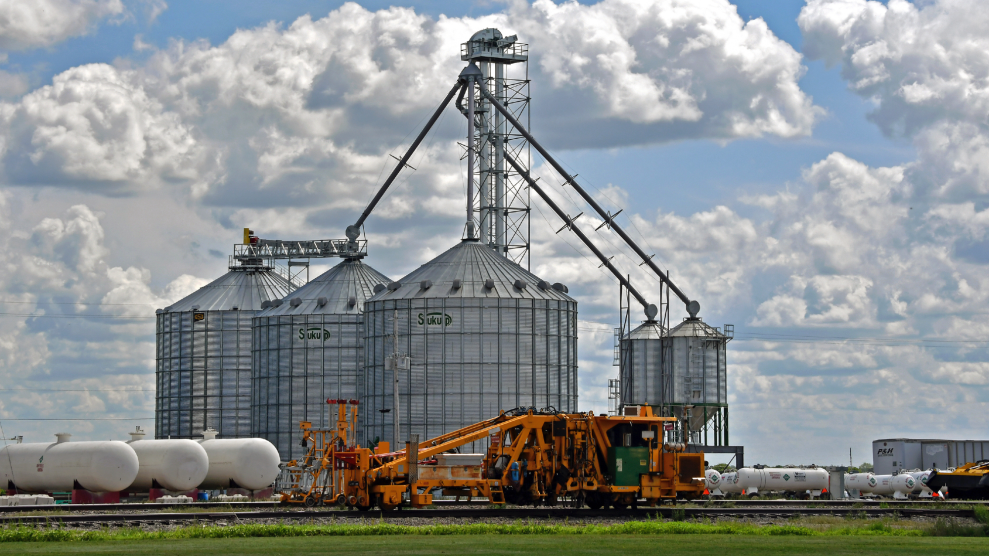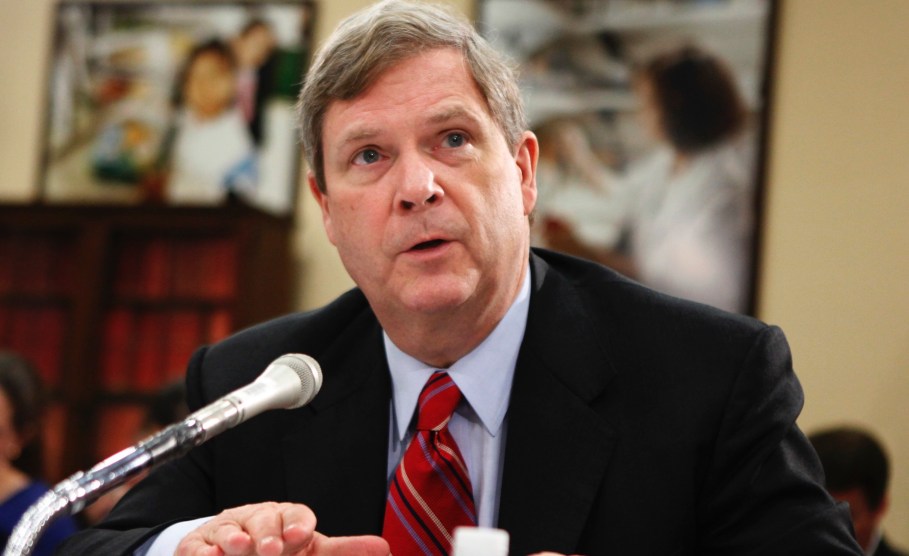
Grain storage silos located along side railroad tracks in rural Lebo, Kansas. Mark Reinstein/AP
This story was originally published by Wired and is reproduced here as part of the Climate Desk collaboration.
Agriculture is a big source of emissions. In the US, about 10 percent of greenhouse gases come from livestock or crops—and for a long time, agriculture has lagged behind other sectors when it comes to cutting its carbon footprint. Since 1990, total emissions from agriculture have risen by 7 percent, while emissions from sectors like electricity generation and buildings have declined.
There’s a simple reason for this: Cutting emissions from agriculture is really hard. It’s not like the energy industry, which has readily available low-carbon electricity in the form of renewables. Reducing agriculture’s impact means making tough decisions about what gets farmed and how, and dealing with the notoriously tricky science of making sure carbon stays in the ground rather than being released into the atmosphere.
The US has started getting to grips with these tough decisions. President Biden’s Inflation Reduction Act included $20 billion to help farmers tackle the climate crisis. And in February 2022 the US Department of Agriculture announced $3.1 billion in funding through a scheme called Partnerships for Climate-Smart Commodities (PCSC). The money was intended to fund projects that help farmers adopt more environmentally friendly ways of farming and create a market for what the USDA calls “climate-smart” crops and livestock.
According to the USDA, its plan has the potential to sequester 60 million metric tons of carbon dioxide equivalents—the same as removing 12 million gasoline-powered cars from roads for one year. But some scientists are worried that the PCSC approach is the wrong kind of climate intervention. The government could be channeling billions of dollars to projects that are of uncertain benefit in terms of emissions—or, worse, actually end up increasing overall levels of greenhouse gases.
If the goal is to reduce overall emissions from agriculture, a good place to start is by figuring out where all those emissions come from. It turns out that over half of all agricultural emissions come in the form of nitrous oxide—a potent greenhouse gas released when microbes in the soil break down nitrogen-based fertilizers. Overuse of fertilizer is a huge problem in agriculture, says Paul West, an ecologist at the climate nonprofit Project Drawdown. On top of being a huge source of emissions, excess nitrogen leaches into waterways, causing algal blooms.
Reducing the amount of fertilizer farmers use would be a big win. Remote sensors and machines can help farmers apply fertilizer only when and where it is needed, while smarter forms of fertilizers might reduce the amount of nitrogen that ends up digested by microbes. The crucial thing about these kinds of interventions is that they stop emissions being released in the first place, says Dan Blaustein-Rejto, director of food and agriculture at the Breakthrough Institute. If you never put fertilizer on the ground, it’s impossible for microbes to turn it into planet-warming nitrous oxide. Getting smarter with fertilizer use is one of the biggest changes that US agriculture could make to its emissions footprint.
But fertilizer management plays second fiddle to a different kind of climate project in the PCSC. Of the 60 finalized projects for which the USDA has published summaries, only 12 mention nutrient management or fertilizer application. A much higher number of projects focus on cover cropping—a technique that involves covering fields with crops between harvests in order to slow soil erosion, capture carbon, and keep nutrients in the fields. Since planting cover crops takes time and expense, and can lower the overall productivity of fields, only a relatively small number of farmers use the technique. If the PCSC is successful, however, the number of farmers planting cover crops should shoot up.
Cover crops absorb carbon from the atmosphere and turn it into plant material as they grow, explains Deepak Joshi, an assistant professor at Arkansas State University and the author of a recent paper about cover crops. When the cover crops are harvested or left to rot on the soil, a lot of that carbon gets released back into the atmosphere, but a small amount can remain behind in the soil. If that soil remains undisturbed, then that carbon can potentially remain underground for years. Joshi’s meta-analysis focused on cover crops grown in cornfields around the world and found that, on average, cover crops increased carbon stored in the soil by about 7 percent.
So far, so good. But once you dive down into the details of Joshi’s study, things get more complicated. The research found that the amount of carbon stored varied widely, depending on location, cover crop type, plowing, and the amount of plant growth. A different review, this time examining cover cropping on US farms, found that, in lots of cases, fields with cover crops didn’t gain extra soil carbon when compared to fields that hadn’t been cover cropped. “In terms of climate benefit, it isn’t all that great,” says West.
One of the big limitations to cover cropping is that carbon added to the soil might eventually make its way back into the atmosphere. “What we find is that even where there is a build-up of carbon, once you plow those areas again you lose a lot—or all—of the carbon that has been stored up over time,” says West. If money for cover crops runs out, farmers may start leaving fields bare during off-seasons and plowing them more, which would mean a lot of that sequestered carbon would end up back in the atmosphere. And if the cover crops reduce the overall productivity of fields, there’s also the danger that the practice might encourage more land to be converted to agriculture, which is bad news for overall emissions.
Blaustein-Rejto and West both worry that the PCSC prioritizes sequestering carbon rather than stopping emissions from being released in the first place. One way to think about this is the difference between switching to an electric car today or continuing to drive a gas-powered vehicle while also planting a forest to sequester the carbon you emit. In both cases the overall carbon accounting may net out the same, but sequestering always carries the risk that the carbon might later be released if—for instance—that forest is replaced by a cattle ranch.
Robert Bonnie, the under secretary for agriculture for farm production and conservation at the USDA, says that criticisms of the PCSC aren’t entirely fair. “These are pilots. We’re actually going to go out and try some things. We don’t have all the information we need,” he says. He points out that a number of the funded projects do focus on fertilizer use. “We’re not scared of the math; we’re really interested in getting the math right,” he says.
Bonnie says that the real challenge is to persuade farms to get on board with climate-smart farming. A big focus of the project is to create a market for climate-smart crops and livestock, encouraging buyers to pay a premium for goods made in an environmentally friendly manner. A top-down regulatory approach might discourage farmers from taking part, he says.
In lots of the PCSC projects, the USDA funding is supplemented by money from food companies that buy beef, corn, soy, or other agricultural commodities. One PCSC project run by the Iowa Soybean Association includes $62.1 million in corporate payments from companies including PepsiCo, Cargill, Target, JBS, and Coca-Cola. This is a relatively new form of carbon accounting called insetting, where companies pay for carbon offsets within their own supply chains.
Insetting is rising in popularity, but it has a lot of the same problems as offsets, says Sybrig Smit of the NewClimate Institute, a climate policy and global sustainability nonprofit based in Germany. It might be difficult to assess whether insets deliver their supposed benefits, and sequestering carbon is still less desirable than cutting emissions at their source, particularly when it helps sustain industries that are bigger emitters of carbon. Livestock is the second-biggest source of emissions in US agriculture, so reducing consumption of meat and dairy products is an obvious way to reduce emissions, says Smit. “As a society we’re really scared to touch on our consumption patterns,” she says.
The USDA scheme is stuck in an awkward place. It is supposed to reduce emissions but seeks to achieve that in a way that keeps farmers on board and doesn’t fundamentally change the goods they produce. “We’re going to have beef production and dairy production for a long time to come. And our job is to figure out how to work with those producers to reduce the greenhouse gas impacts to the maximum extent we can,” Bonnie says.
In practice, that means that much money from PCSC will go toward farming soy and corn—a large percentage of which will end up as livestock feed or as ethanol for biofuels. Cover cropping is good for soil health, but its potential to lead to long-lasting carbon storage is uncertain at best. At worst, it could see the US avoiding the kind of fundamental changes to food production that could really bring emissions down.








